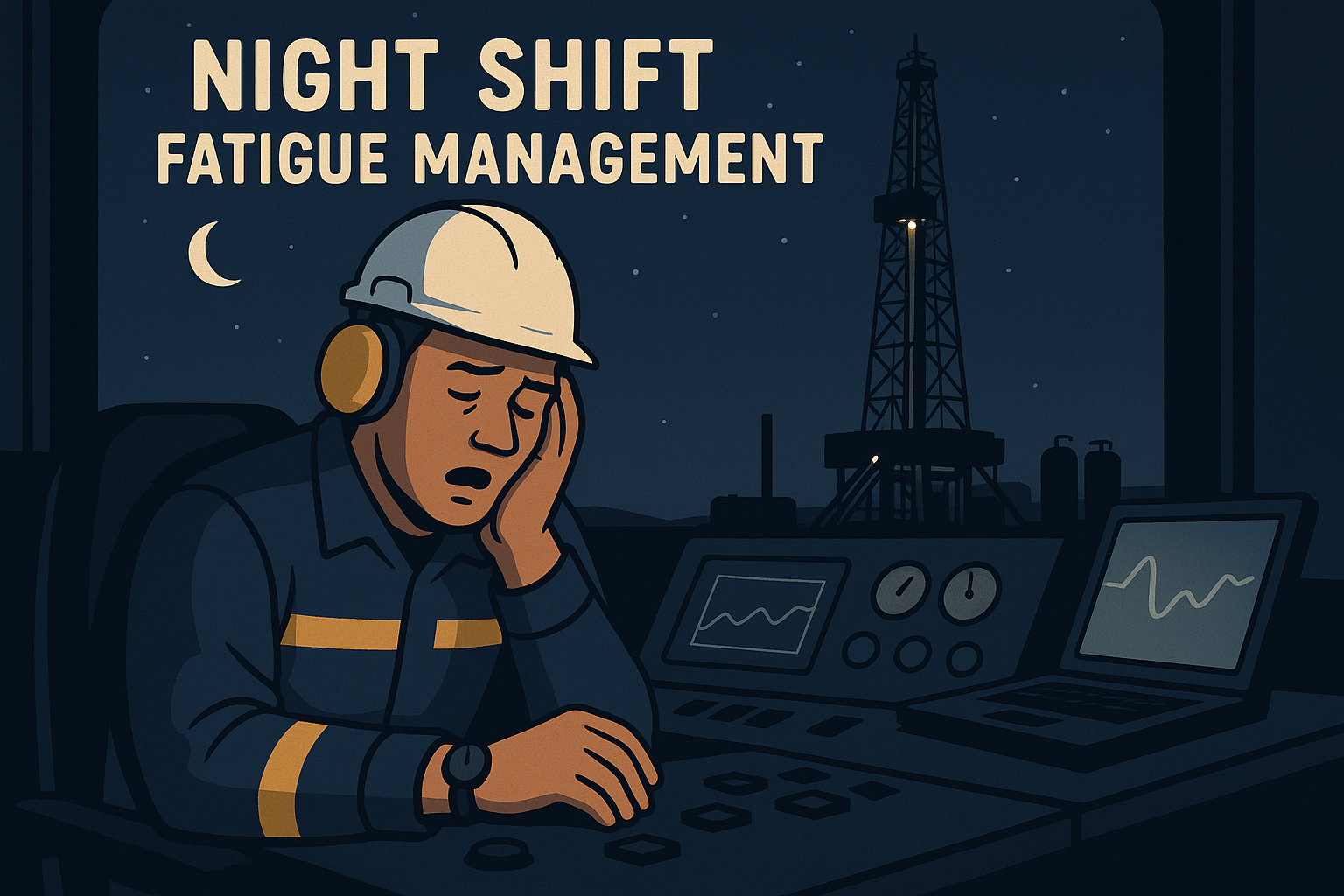In the mining industry, where 24/7 operations are the norm, ensuring the safety and well-being of workers is paramount. Designing shift schedules that align with employees' natural circadian rhythms has emerged as a critical strategy for optimizing performance and mitigating fatigue-related risks.
Circadian rhythms—the internal biological processes that regulate sleep-wake cycles—play a vital role in determining alertness, cognitive function, and overall health. By understanding and leveraging these rhythms, mining organizations can create schedules that support worker well-being and enhance operational efficiency.
Implementing circadian rhythm scheduling in mining requires a comprehensive approach that considers various factors, such as shift rotation patterns, chronotype-adjusted schedules, and fatigue risk assessment. By adopting evidence-based practices and leveraging advanced technologies, mining companies can unlock the potential for improved safety, productivity, and employee satisfaction.
What is Circadian Rhythm Scheduling in Mining?
Circadian rhythm scheduling in mining involves designing shift schedules that align with the natural biological rhythms of workers to enhance safety, productivity, and overall well-being. This approach acknowledges the impact of circadian rhythms on alertness and performance, aiming to reduce fatigue and improve operational efficiency.
Mining operations often require continuous work, with employees working extended hours and rotating shifts. However, when shift schedules are misaligned with workers' circadian rhythms, it can lead to sleep disruption, fatigue accumulation, and impaired cognitive function. This not only compromises the health and well-being of employees but also increases the risk of accidents and errors on the job.
By implementing circadian rhythm scheduling, mining organizations can create work schedules that optimize the body's natural peaks and troughs in alertness. This involves considering factors such as shift rotation patterns, shift length, and rest periods to ensure that workers have adequate time for sleep and recovery.
Research has shown that aligning shift schedules with circadian rhythms can yield significant benefits. A study published in the Journal of Occupational and Environmental Medicine found that implementing a circadian-friendly shift schedule in a mining operation led to a 20% reduction in fatigue-related incidents and a 15% increase in productivity.
To effectively implement circadian rhythm scheduling, mining companies can leverage tools and technologies that assist in fatigue risk assessment and schedule optimization. For example, predictive modeling software can simulate the impact of different shift patterns on worker fatigue levels, allowing organizations to make data-driven decisions.
Furthermore, mining companies can adopt chronotype-adjusted schedules, which take into account individual differences in sleep-wake preferences. By accommodating the natural tendencies of "morning larks" and "night owls," organizations can create personalized schedules that enhance worker well-being and performance.
Implementing circadian rhythm scheduling in mining requires a holistic approach that goes beyond just designing schedules. It involves fostering a culture of fatigue management, providing education and training on sleep hygiene, and regularly monitoring and assessing the effectiveness of the implemented strategies.
By prioritizing circadian rhythm scheduling, mining organizations can demonstrate their commitment to employee well-being and safety. This not only benefits the workers themselves but also contributes to the overall success and sustainability of the mining operation.
How to Design Shift Schedules Aligning with Circadian Rhythms
Creating effective shift schedules requires a strategic approach that considers the natural biological rhythms of workers. Schedules should be designed to align with these rhythms, reducing fatigue and promoting optimal performance. By structuring work hours around peak alertness times—typically mid-morning and mid-afternoon—organizations can enhance productivity and reduce the risk of fatigue-related incidents.
Evaluating Fatigue Risk Factors
A thorough evaluation of fatigue risk factors is crucial for developing schedules that align with workers' natural rhythms. This process involves reviewing current shift structures to identify potential issues such as extended work hours or inadequate rest between shifts. By using analytical tools, organizations can predict fatigue levels under various scheduling scenarios, enabling informed decision-making that prioritizes employee health.
Incorporating Individual Sleep Preferences
Acknowledging the diverse sleep preferences of employees can significantly improve well-being and job satisfaction. Tailoring shift start times to suit individual sleep patterns allows employees to work when they are naturally more alert. Offering flexible scheduling options that accommodate these preferences can boost morale and support a healthier work-life balance. Continuous feedback and data-driven adjustments ensure these schedules remain effective and aligned with organizational objectives.
Implementing Strategic Shift Rotations
Strategically rotating shifts helps mitigate the impact of circadian disruption. Utilizing forward-moving rotation patterns eases adaptation by aligning with the body's natural tendency to adjust to later hours. Limiting the frequency of consecutive night shifts further reduces accumulated fatigue, supporting sustained performance and safety. Consulting established guidelines for 24-hour operations can provide additional insights for maintaining productivity.
Utilizing Advanced Monitoring Tools
Incorporating advanced monitoring tools enhances the management of shift schedules. Real-time fatigue monitoring solutions offer critical insights into employee alertness, allowing for timely interventions. By analyzing data trends, organizations can make evidence-based schedule adjustments that align with circadian principles. This approach not only supports immediate feedback for supervisors and workers but also aids in refining strategies for long-term effectiveness.
By adopting these strategies, mining organizations can establish shift schedules that prioritize worker health and safety while optimizing operational efficiency. Such practices not only reduce fatigue but also foster an environment where employees feel supported and valued, contributing to the organization's sustained success.
1. Conduct a Fatigue Risk Assessment
Initiating a thorough fatigue risk assessment is vital to crafting shift schedules that harmonize with circadian rhythms. This process requires a systematic review of current shift configurations to uncover elements that might lead to employee exhaustion. Common issues such as extended working hours and inadequate recovery time between shifts can disrupt sleep cycles and impair performance.
Detecting Fatigue Triggers
To effectively address fatigue, it's essential to identify the underlying triggers within current scheduling practices. Key indicators include persistent tiredness, reduced output, and a higher frequency of mistakes or incidents. By collecting and analyzing this data, organizations can target specific scheduling challenges that need adjustment to enhance worker safety and health.
Utilizing Analytical Models for Forecasting
Incorporating advanced analytical models into the fatigue risk assessment provides actionable foresight into how different shift designs might impact fatigue. These models allow organizations to explore various scheduling configurations and predict their effects on worker alertness. By embracing technology, companies can gain a nuanced understanding of the interplay between shift patterns and fatigue, paving the way for informed decision-making.
Crafting a Targeted Action Plan
With insights gained from the assessment, organizations can devise a targeted action plan to mitigate fatigue-related issues. This may involve tailoring shift durations, optimizing rotation schemes, or enhancing rest opportunities to facilitate recovery. A data-informed strategy ensures that scheduling modifications not only address fatigue but also align with the overarching objectives of organizational efficiency and employee well-being.
By conducting a detailed and insightful fatigue risk assessment, mining operations can set the stage for shift schedules that align with and support the natural circadian rhythms of their workforce. This critical step is essential for ensuring operational success and fostering a culture of safety and care within the industry.
2. Implement Chronotype-Adjusted Schedules
Integrating chronotype-adjusted schedules into mining shift designs can significantly improve both employee satisfaction and operational efficiency. By acknowledging that workers have unique periods of peak alertness, organizations can better align work hours with natural energy cycles. This approach enhances productivity by capitalizing on times when employees are naturally more focused and energetic.
Leveraging Individual Alertness Patterns
Employees exhibit varied alertness patterns, often classified into early risers and late starters. Recognizing these differences allows companies to arrange shifts that match workers' natural productivity windows. Conducting assessments to determine individual alertness patterns enables organizations to assign shifts that align with these timeframes, thereby minimizing disruptions to natural sleep cycles and boosting overall job satisfaction.
Creating Adaptive Scheduling Solutions
Adopting adaptive scheduling solutions involves moving away from uniform shift assignments to more personalized approaches. By implementing systems that permit flexible shift start times, organizations can support employees' natural inclinations. Offering choices between morning or evening shifts empowers workers to select schedules that align with their personal productivity peaks, promoting a healthier work-life balance and reducing stress.
Engaging in Ongoing Evaluation and Adjustment
Regular evaluation and adjustment of shift schedules based on performance data and employee input are critical for maintaining alignment with natural rhythms. Gathering insights from workers about their schedule preferences and experiences provides valuable information for fine-tuning shift arrangements. By continuously analyzing data and seeking employee feedback, organizations can optimize shift schedules to better match chronotypes, ensuring sustained productivity and safety.
This ongoing process of evaluation and refinement not only supports high levels of performance and safety but also cultivates a workplace culture centered around adaptability and employee well-being. Through carefully calibrated chronotype-adjusted scheduling, mining operations can achieve a productive synergy between workforce capabilities and operational goals.
3. Optimize Shift Rotation Patterns
Crafting effective shift rotation patterns in mining operations is vital for both maintaining worker well-being and optimizing operational efficiency. Employing a strategic approach to shift rotations can significantly impact the circadian alignment of schedules, thereby enhancing alertness and reducing fatigue-related risks.
Facilitating Seamless Transitions
- Sequential Shift Advantages: Sequential shift patterns, where shifts progress in a logical sequence, aid in maintaining a stable rhythm, allowing the body to adjust more naturally. This method supports consistent energy levels and cognitive clarity throughout work periods.
- Night Shift Management: Carefully managing the frequency and duration of night shifts is critical. By ensuring adequate intervals between night shifts, organizations can prevent fatigue buildup, promoting sustained vigilance and health.
Adopting Proven Schedule Design Principles
Incorporating well-researched schedule design principles helps create shifts that balance operational needs with employee health. Following established methodologies, such as those utilized in industries with similar demands, provides a foundation for designing shifts that optimize both productivity and safety.
Integrating Flexibility with Consistency
- Adaptive Scheduling Frameworks: While structured shift patterns provide consistency, integrating adaptive elements can address individual worker needs. Allowing some degree of flexibility within fixed schedules can enhance job satisfaction and reduce stress.
- Data-Driven Refinement: Utilizing data insights to regularly refine shift patterns ensures they remain effective and responsive to changing conditions. By analyzing performance metrics, organizations can make informed adjustments that align with contemporary operational goals and worker well-being.
With a focus on thoughtful shift rotation design and ongoing evaluation, mining operations can create work environments that support employee health and optimize productivity. This balanced approach not only mitigates fatigue but also fosters a workforce that is both resilient and engaged.
4. Integrate Technology and Data Analytics
Incorporating cutting-edge technology and data analytics is essential for developing shift schedules that are in harmony with the circadian rhythms of mining workers. By utilizing sophisticated software platforms, companies can gather and analyze data on workforce alertness, allowing for precise adjustments to schedules that enhance employee performance and safety. This data-centric strategy empowers organizations to proactively address fatigue-related challenges, ensuring operational excellence.
Comprehensive Monitoring for Strategic Insights
Deploying comprehensive fatigue monitoring systems offers a detailed perspective on employee fatigue, enabling timely and strategic decision-making. These systems provide continuous data on worker alertness and cognitive function, offering insights into how different shifts impact health and productivity. Equipped with this data, organizations can make proactive adjustments to schedules, maintaining high standards of safety and operational effectiveness.
- Advanced Data Modeling: Leveraging advanced data modeling techniques allows organizations to foresee potential fatigue issues associated with specific shift structures. This predictive capability facilitates preemptive schedule modifications to avert disruptions and optimize efficiency.
Data Utilization for Schedule Optimization
The application of data analytics to shift scheduling provides a robust framework for enhancing workforce management strategies. Through the examination of performance data trends, companies can refine shift rotations and customize schedules to better align with workers' natural cycles. This continuous refinement process ensures that scheduling practices remain responsive to the latest insights, fostering a culture of adaptability.
- Iterative Feedback Mechanisms: Establishing iterative feedback mechanisms between workforce analytics and management practices allows for ongoing improvement of shift configurations. This approach ensures schedules are aligned with organizational demands and responsive to employee needs.
Enhancing Communication and Feedback Mechanisms
Technology also facilitates improved communication between employees and management, offering platforms for real-time feedback and collaboration. This connectivity empowers workers to share valuable insights, enabling the customization of schedules to optimize safety and satisfaction. By utilizing these technological tools, organizations can nurture a participative and engaged workforce, driving sustained operational success.
- Instant Communication Solutions: Implementing systems for instant communication between supervisors and workers ensures timely responses to deviations in performance. This real-time connectivity supports a responsive approach to managing workforce fatigue, enhancing the overall efficacy of circadian rhythm-aligned scheduling strategies.
By strategically integrating technology and data analytics, mining organizations can achieve a balance between operational requirements and employee well-being. This integration not only boosts productivity but also cultivates a resilient workforce capable of thriving in demanding environments.
Tips on Reducing Fatigue and Enhancing Performance
Addressing fatigue and boosting performance in mining operations demands an integrated strategy that combines awareness, behavioral changes, and innovative solutions. Implementing targeted initiatives that cater to both physical and mental demands helps build a robust operational framework.
1. Promote Sleep Hygiene
- Sleep Education Programs: Develop initiatives that inform employees about the crucial role of sleep consistency in maintaining energy and focus. Organize sessions that teach workers about creating optimal sleep conditions and adhering to sleep-friendly routines, empowering them to prioritize rest.
- Practical Guidance: Share practical guidelines, such as reducing screen time before bed and cultivating a tranquil sleep environment, to improve rest quality. Encouraging these practices helps establish a workforce culture that values and supports restorative sleep.
2. Foster a Culture of Safety
- Open Dialogue: Create a platform for honest discussions where employees can voice concerns about fatigue without fear of repercussions. Facilitating regular safety briefings and anonymous surveys encourages transparency and proactive problem-solving.
- Leadership Role Modeling: Leaders should exemplify a commitment to safety by consistently following and promoting fatigue management practices. This top-down approach reinforces the organization's dedication to health and safety, motivating employees to adhere to established protocols.
3. Provide Training and Resources
- Skill-Building Workshops: Implement workshops that focus on mastering shift work challenges and achieving a balanced lifestyle. Topics can cover stress management, effective time allocation, and understanding the physiological effects of irregular hours.
- Supportive Resources: Ensure employees have access to wellness initiatives, mental health resources, and fatigue management tools that aid in maintaining resilience and performance in demanding environments.
4. Encourage Breaks and Rest Periods
- Scheduled Breaks: Design shift structures that incorporate frequent, scheduled breaks to allow workers to recharge and maintain concentration throughout their shifts. Such regular intervals are essential for sustaining long-term engagement and productivity.
- Rest Zones: Equip workplaces with rest zones that offer a relaxing atmosphere to enhance the restorative quality of breaks. These spaces encourage employees to fully utilize their downtime, promoting recovery and rejuvenation.
5. Continuously Monitor Fatigue with Readi Fatigue Risk Management Technology
- Proactive Monitoring: Employ Readi technology to continuously track fatigue levels, providing valuable insights into workforce readiness. This real-time data enables managers to implement timely solutions that mitigate fatigue and support optimal performance.
- Insight-Driven Decisions: Use the data collected from monitoring systems to make evidence-based adjustments to operations. This iterative process ensures that fatigue management strategies evolve in response to shifting conditions, aligning with organizational objectives and employee needs.
By incorporating these fatigue management strategies into mining operations, companies can enhance the work environment to support safety and efficiency. Through proactive measures and continuous improvements, organizations can cultivate a resilient workforce that thrives in challenging conditions.
Related Posts
-
Understanding Workplace Accidents Caused by FatigueSummary Fatigue causes 13%+ of workplace injuries and impairs critical safety functions. Shift work and long hours are major...
-
Night Shift Fatigue Management: 10 Actionable Strategies for Health and Safety Leaders Managing Night Shift TeamsSummary Night shift fatigue management reduces accidents, improves productivity, and supports employee well-being. Readi’s...
-
How to Balance Shift Schedules and Productivity in Heavy IndustryIn heavy industries, where continuous operations are essential, shift work is a common practice. However, the nature of shift...




